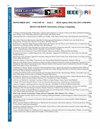基于暂态电流的DFIG和PMSG配电网故障区段识别
IF 1.3
4区 工程技术
Q3 COMPUTER SCIENCE, INFORMATION SYSTEMS
引用次数: 0
摘要
提出了一种嵌入式风力发电配电网故障段识别方法。相电流仅在配电变电所(DS)测量,使用两个周期的波形窗(一个在故障检测之前,一个在故障检测之后)。该方法分为两个阶段:第一阶段,故障识别(FI),旨在识别短路故障是在主馈线上还是在其中一个分支上,有效地解决了当多个分支对应于估计的故障点时可能出现的多个故障位置的挑战;第二阶段,故障定位(FL),估计DS和故障定位之间的距离。该算法将离散小波变换(DWT)与人工神经网络(ann)相结合。基于DWT分解,提出并计算了单位(EPU和REEPU)的能量和相对能量熵,并将正则化指标应用于EPU和REEPU。这些指标作为多层神经网络模型的输入,作为FI的分类器和FL的预测器。利用MATLAB软件和IEEE 34节点基准馈线作为测试系统,模拟了具有不同故障起始角度、故障类型、故障电阻和故障定位的各种故障场景。结果表明,该方法有效地完成了FSI任务,FI的准确率高达95%,FL的最大误差为5.2%。本文章由计算机程序翻译,如有差异,请以英文原文为准。
Fault Section Identification in Distribution Networks with DFIG and PMSG Generators Using Current Transients
This paper presents a methodology for fault section identification (FSI) in distribution networks with embedded wind power generation. The phase currents are measured only at the distribution substation (DS), using a waveform window of two cycles (one before and one after the fault detection). The proposed approach is divided into two stages: the first stage, Fault Identification (FI), aims to identify whether a short-circuit fault lies on a main feeder or one of the branches effectively addressing the challenge of multiple fault locations that may arise when several branches correspond to the estimated fault point; the second stage, Fault Location (FL), estimates the distance between the DS and the fault location. The algorithm employs discrete wavelet transform (DWT) in combination with artificial neural networks (ANNs). Energy and Relative Energy Entropy, both in per unit (EPU and REEPU), are proposed and calculated from DWT decomposition, with regularization indexes applied to EPU and REEPU. These indexes serve as input to multi-layer ANN models, which work as classifiers for FI and predictors for FL. Various fault scenarios with different fault inception angle, fault type, fault resistance and fault location are simulated using MATLAB software and the IEEE 34-node benchmark feeder as test system. The results demonstrate that the proposed methodology performs effectively the FSI task, achieving an accuracy of up to 95% for FI and a maximum error of 5.2% for FL.
求助全文
通过发布文献求助,成功后即可免费获取论文全文。
去求助
来源期刊

IEEE Latin America Transactions
COMPUTER SCIENCE, INFORMATION SYSTEMS-ENGINEERING, ELECTRICAL & ELECTRONIC
CiteScore
3.50
自引率
7.70%
发文量
192
审稿时长
3-8 weeks
期刊介绍:
IEEE Latin America Transactions (IEEE LATAM) is an interdisciplinary journal focused on the dissemination of original and quality research papers / review articles in Spanish and Portuguese of emerging topics in three main areas: Computing, Electric Energy and Electronics. Some of the sub-areas of the journal are, but not limited to: Automatic control, communications, instrumentation, artificial intelligence, power and industrial electronics, fault diagnosis and detection, transportation electrification, internet of things, electrical machines, circuits and systems, biomedicine and biomedical / haptic applications, secure communications, robotics, sensors and actuators, computer networks, smart grids, among others.
 求助内容:
求助内容: 应助结果提醒方式:
应助结果提醒方式:


